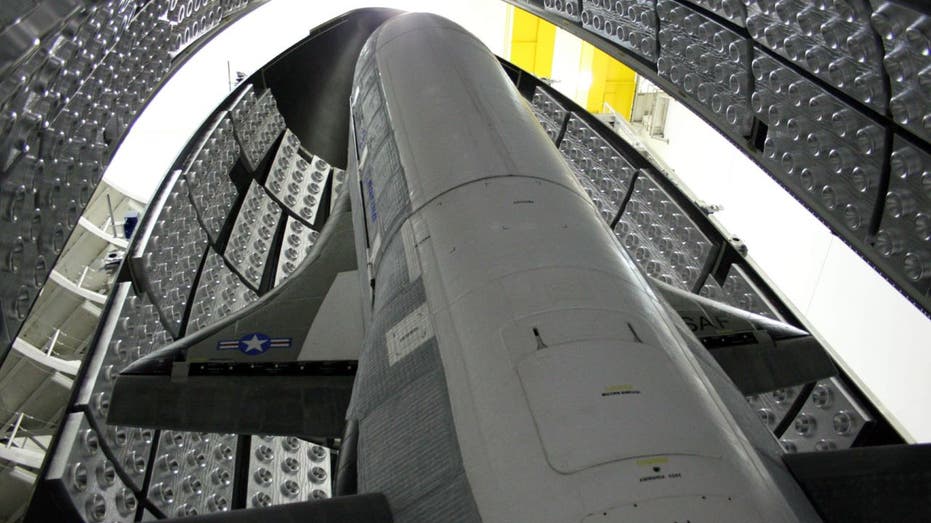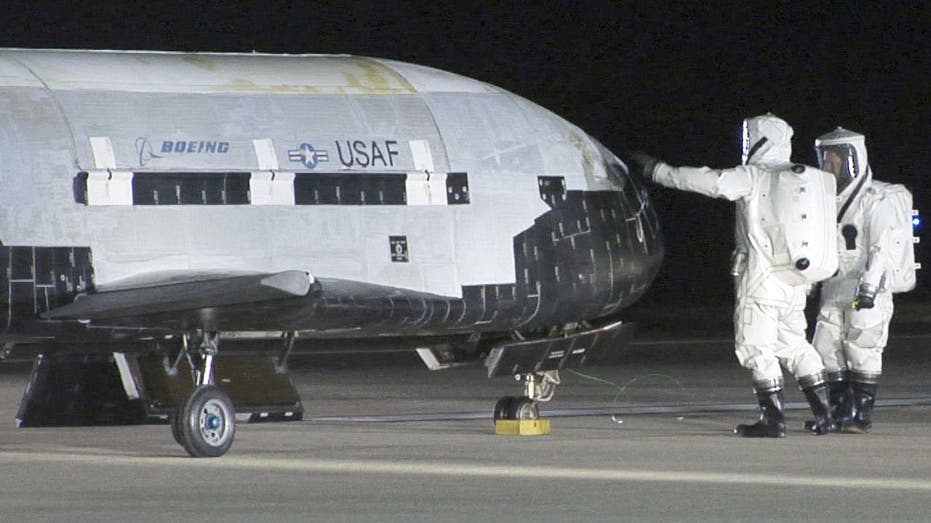SpaceX launches X-37B aboard a Falcon Heavy rocket at Kennedy Space Center
The mission marks the first time SpaceX's Falcon Heavy rocket has been used to launch the Boeing X-37B into orbit
DOJ suit against Elon Musks SpaceX is hypocrisy: Legal expert Roger Severino
Former DOJ civil rights attorney Roger Severino weighs in on the DOJ filing a lawsuit accusing SpaceX of hiring discrimination against refugees and asylum recipients on The Evening Edit.
Elon Musk’s SpaceX on Thursday successfully launched the Pentagon’s secretive X-37B spacecraft after the mission was delayed for several weeks due to weather and other issues.
SpaceX launched the X-37B aboard a Falcon Heavy rocket from the Kennedy Space Center in Florida Thursday evening – marking the first time the rocket has carried the Space Force’s X-37B. On its six previous trips into orbit, the spacecraft was launched by United Launch Alliance Atlas V or SpaceX Falcon 9 rockets.
The launch was initially scheduled for Dec. 10 but was postponed multiple times that week due to poor weather conditions and on one occasion due to what SpaceX said was a "ground side issue" shortly before one of the scheduled liftoffs. SpaceX said the delays allowed its teams to conduct additional systems checks in advance of this launch window.
The Boeing X-37B is an unmanned, robotic spacecraft operated by the Air Force’s Rapid Capabilities Office in collaboration with the Space Force. Its design resembles a smaller version of the Space Shuttle and is based on an earlier variant of the spacecraft used by the National Aeronautics and Space Administration (NASA), known as the X-37A.
SPACEX DELAYS LAUNCH OF SECRET SPACE FORCE MISSION

The X-37B seen in an encapsulation cell prior to a launch in 2010. The X-37B is an advanced unmanned and reusable spacecraft. ((Courtesy Photo by DoD/Corbis via Getty Images) / Getty Images)
Also known as the Orbital Test Vehicle, the X-37B is designed as a reusable spacecraft launched vertically into orbit by a launch vehicle and eventually re-enters Earth’s atmosphere as a spaceplane landing horizontally on a runway like the Space Shuttle.
| Ticker | Security | Last | Change | Change % |
|---|---|---|---|---|
| BA | THE BOEING CO. | 173.49 | +6.27 | +3.75% |
The Air Force has said it’s the first vehicle since NASA’s shuttle orbiter with the ability to return experiments performed in space to Earth for analysis.
While many details of the X-37B’s payload, operations and testing remain secret, the service has made public some general information about the technologies tested by the X-37B. A fact sheet indicated it serves as a test bed for systems such as advanced guidance, navigation and control, thermal protection systems, avionics, high-temperature structures and seals, conformal reusable insulation, lightweight electromechanical flight systems, advanced propulsion systems, advanced materials and autonomous orbital flight.
SPACEX WINS REPRIEVE FROM DOJ SUIT ALLEGING HIRING DISCRIMINATION

A United Launch Alliance Atlas V rocket carrying the X-37B Orbital Test Vehicle (OTV-6) launches from pad 41 at Cape Canaveral Air Force Station on May 17, 2020 in Cape Canaveral, Florida. ((Photo by Paul Hennessy/NurPhoto via Getty Images) / Getty Images)
The X-37B is designed to remain in space for extended-duration missions lasting at least 270 days, though some missions have lasted much longer. The X-37B’s fifth mission reached 780 days in orbit, while its sixth mission ran from May 17, 2020, to Nov. 12, 2022, a total of 908 days in orbit.
In 2019, former Air Force Secretary Heather Wilson said the X-37 was "fascinating" because it can turn to alter its orbit when it’s close to the Earth. She added that "means our adversaries don’t know… where it’s going to come up next."
The X-37 mission's latest mission is the spacecraft’s seventh spaceflight since its debut in April 2010.
GET FOX BUSINESS ON THE GO BY CLICKING HERE

Technicians in self-contained atmospheric protective ensemble suits conduct initial checks on the X-37B Orbital Test Vehicle 1 after its landing Dec. 3, 2010, at Vandenberg Air Force Base, Calif., following its maiden voyage. (Photo by U.S. Air Force photo/Michael Stonecypher/DoD/Corbis via Getty Images / Getty Images)
This mission was the fifth for the SpaceX Falcon Heavy's side booster rockets, which are scheduled to make a recovery landing at two of the Cape Canaveral Space Force Station’s landing zones a little over eight minutes after launch.
